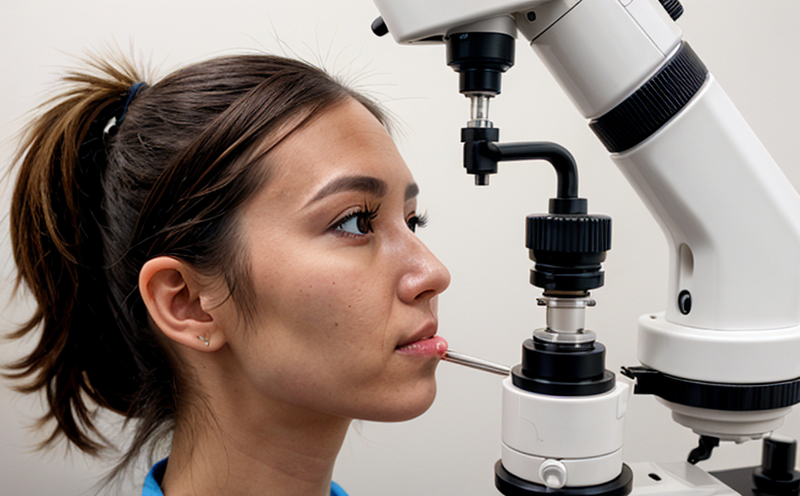ASTM D4169 Transport Simulation Testing for Ophthalmic Devices
The ASTM D4169 test method is a critical standard designed to evaluate the durability of ophthalmic devices during transportation. This testing simulates real-world conditions such as vibration, shock, and temperature changes that ophthalmic devices may encounter in transit. The primary objective is to ensure that these medical devices maintain their integrity, functionality, and safety throughout shipping processes.
The ASTM D4169 standard covers a comprehensive range of factors including mechanical stress from road and air transportation, environmental conditions like temperature fluctuations, and potential external impacts. This testing protocol is essential for manufacturers aiming to meet regulatory requirements and ensure product reliability in the healthcare industry.
During the test, ophthalmic devices are subjected to controlled vibrations that mimic the rough roads or turbulent flights they might experience during shipment. Temperature cycling simulates changes between ambient conditions and storage temperatures, which can vary widely depending on shipping routes and storage facilities. Additionally, drop tests assess the device’s resilience to potential impacts from packaging failure.
Preparing specimens for ASTM D4169 testing involves ensuring that the devices are representative of those intended for clinical use. This includes proper packaging to simulate real-world conditions as closely as possible. The test setup replicates various modes of transportation, including ground transport via trucks and trains, and air transport using aircraft.
Instrumentation used in ASTM D4169 testing includes shakers that generate controlled vibrations, temperature chambers for simulating different environmental temperatures, and drop testers to evaluate impact resistance. The test protocol specifies the exact conditions under which each type of stress is applied, ensuring consistent results across multiple tests.
The acceptance criteria for ASTM D4169 are stringent, focusing on both mechanical integrity and functional performance. Devices that pass these tests must demonstrate no significant damage or degradation in performance after exposure to simulated transportation conditions. Compliance with this standard not only enhances the safety of patients but also supports regulatory compliance.
The importance of ASTM D4169 testing cannot be overstated, especially given the critical nature of ophthalmic devices used for diagnosing and treating eye diseases. By adhering to these standards, manufacturers can ensure their products are robust enough to withstand the rigors of transportation without compromising on quality or performance.
In summary, ASTM D4169 transport simulation testing is a vital component in the development and quality assurance process for ophthalmic devices. It ensures that these medical devices remain safe, effective, and reliable during all stages of their journey from manufacturer to patient.
Applied Standards
- American Society for Testing and Materials (ASTM) D4169: Standard Practice for Transportation Simulation Testing of Medical Devices
The ASTM D4169 standard is widely recognized in the medical device industry as a means to ensure that ophthalmic devices can withstand the rigors of transportation. This standard specifies detailed procedures and conditions under which test specimens are subjected to simulated transport environments, including vibration, shock, and temperature cycling.
By adhering to ASTM D4169, manufacturers demonstrate their commitment to quality and safety in product design and development. The standard is particularly relevant for ophthalmic devices due to the critical nature of these instruments in diagnosing and treating eye conditions. Ensuring that such devices remain functional after transportation helps maintain patient trust and compliance with regulatory bodies.
The ASTM D4169 protocol covers various modes of transport, including ground (truck and rail) and air shipping methods. The testing replicates real-world scenarios where the device may be exposed to different environmental conditions and mechanical stresses. This comprehensive approach ensures that ophthalmic devices are robust enough to maintain their integrity during transit.
Compliance with ASTM D4169 is essential for medical device manufacturers looking to achieve regulatory approval and market entry in competitive global markets. It also supports the continuous improvement of product design and quality assurance processes, ultimately benefiting both healthcare providers and patients.
Benefits
- Ensures product integrity and safety during transportation
- Aids in regulatory compliance with international standards
- Reduces the risk of damage to ophthalmic devices in transit
- Promotes consistent quality across different modes of transport
- Enhances patient trust and satisfaction with medical device reliability
The benefits of ASTM D4169 testing extend beyond mere compliance; they significantly impact the overall quality and safety of ophthalmic devices. By ensuring that these devices can withstand transportation challenges, manufacturers demonstrate their commitment to delivering reliable products to healthcare providers and patients.
Compliance with this standard not only enhances patient safety but also supports regulatory compliance in various countries around the world. This is particularly important given the stringent requirements set by global health authorities like the FDA (Food and Drug Administration) in the United States and the European Commission for medical devices.
The testing process helps manufacturers identify potential weaknesses in their products before they reach the market, allowing for timely corrections and improvements. This proactive approach to quality assurance reduces the likelihood of product failures during transportation, which can lead to costly recalls and negative impacts on brand reputation.
Furthermore, ASTM D4169 testing fosters a culture of continuous improvement within manufacturing processes. By regularly subjecting products to rigorous transport simulations, companies can identify areas for enhancement and innovation. This not only enhances product quality but also positions the manufacturer as an industry leader in terms of reliability and safety.
In conclusion, ASTM D4169 testing offers a multitude of benefits that extend beyond mere compliance. It ensures the integrity and safety of ophthalmic devices during transportation, supports regulatory requirements, reduces risks, enhances quality consistency, and promotes patient trust and satisfaction. These advantages make it an indispensable part of the medical device development process.





